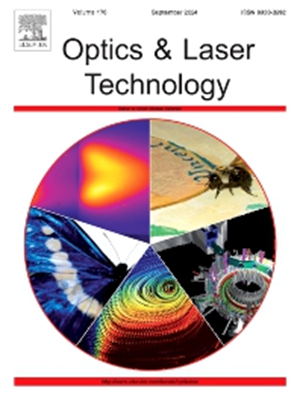Interconnected concentric ring resonator-based plasmonic sensor for ethanol blending detection in fuels
IF 4.6
2区 物理与天体物理
Q1 OPTICS
引用次数: 0
Abstract
A concentric circular ring resonator with a dual stub-based plasmonic sensor configured in Metal Insulator Metal arrangement is investigated in this article. While many recent studies have achieved high sensitivity at the expense of reduced figure of merit (FOM), the proposed sensor is optimized to attain high sensitivity as well as an excellent FOM also. The numerical analysis initially reveals a maximum sensitivity of 1725 nm /RIU and an FOM of 25.7. However, by optimization of geometric parameters, such as mutual gap between the concentric ring (MG), gap between the waveguide and resonator (WG), and stub thickness, the sensor achieves a sensitivity of 1336 nm/RIU with a FOM of 61 in near- infrared region at shorter wavelengths. This optimization offers valuable insights into how these parameters influence its sensing characteristics. The excellent sensing parameters enable the sensor to detect even minimal changes in refractive index, making it suitable for biosensing applications. The sensor demonstrates its ability to identify various types of fuels through refractive index sensing. The sensor further highlights its potential by precisely detecting the concentration of ethanol in ethanol-blended petrol (EBP) and ethanol–diesel (E-diesel), both of which are emerging as promising sustainable alternatives to traditional fossil fuels.
基于互联同心环谐振器的等离子体传感器用于燃料中乙醇混合检测
本文研究了一种采用金属绝缘体金属结构的双桩基等离子体传感器同心圆环形谐振器。虽然最近的许多研究都是以降低优点数(FOM)为代价获得高灵敏度,但所提出的传感器经过优化,既可以获得高灵敏度,又可以获得优秀的FOM。数值分析初步表明,该方法的最大灵敏度为1725 nm /RIU, FOM为25.7。然而,通过对同心圆间距(MG)、波导与谐振腔间距(WG)、短段厚度等几何参数的优化,该传感器在短波长近红外区域的灵敏度达到1336 nm/RIU, FOM为61。这种优化为这些参数如何影响其传感特性提供了有价值的见解。优异的传感参数使传感器能够检测到最小的折射率变化,使其适用于生物传感应用。该传感器展示了其通过折射率传感识别各种类型燃料的能力。该传感器通过精确检测乙醇-混合汽油(EBP)和乙醇-柴油(E-diesel)中乙醇的浓度进一步凸显了其潜力,这两种燃料都是传统化石燃料的有前途的可持续替代品。
本文章由计算机程序翻译,如有差异,请以英文原文为准。
求助全文
约1分钟内获得全文
求助全文
来源期刊
CiteScore
8.50
自引率
10.00%
发文量
1060
审稿时长
3.4 months
期刊介绍:
Optics & Laser Technology aims to provide a vehicle for the publication of a broad range of high quality research and review papers in those fields of scientific and engineering research appertaining to the development and application of the technology of optics and lasers. Papers describing original work in these areas are submitted to rigorous refereeing prior to acceptance for publication.
The scope of Optics & Laser Technology encompasses, but is not restricted to, the following areas:
•development in all types of lasers
•developments in optoelectronic devices and photonics
•developments in new photonics and optical concepts
•developments in conventional optics, optical instruments and components
•techniques of optical metrology, including interferometry and optical fibre sensors
•LIDAR and other non-contact optical measurement techniques, including optical methods in heat and fluid flow
•applications of lasers to materials processing, optical NDT display (including holography) and optical communication
•research and development in the field of laser safety including studies of hazards resulting from the applications of lasers (laser safety, hazards of laser fume)
•developments in optical computing and optical information processing
•developments in new optical materials
•developments in new optical characterization methods and techniques
•developments in quantum optics
•developments in light assisted micro and nanofabrication methods and techniques
•developments in nanophotonics and biophotonics
•developments in imaging processing and systems

 求助内容:
求助内容: 应助结果提醒方式:
应助结果提醒方式:


